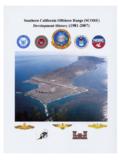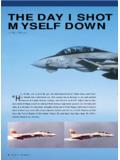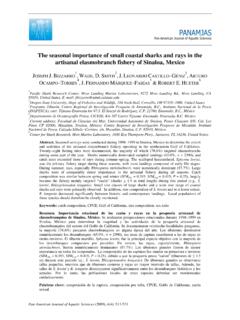Transcription of The impact of human disturbance at seal haul-outs
1 P a g e | 1 1 | P a g e The impact of human disturbance at seal haul - outs A literature review for the seal Conservation Society Susan C. Wilson, BSc, MSc, PhD, LLM Tara seal Research Tara seal Research P a g e | 2 2 | P a g e Summary The intention of this paper is to review the types of human disturbance at pinniped colonies world-wide and summarise the scientific literature assessing the impact of such disturbance . Many studies dating from the 1970s have focused on phocids, mainly harbour seals, and most have concerned recreational disturbance . Since 2000 disturbance of other phocid species have received more attention and there has also been a growing literature on recreational disturbance of otariids (fur seals and sea lions).
2 The types of disturbance described here include tour boats, paddle boats (kayaks and canoes), speed boats and jet-skis and recreational swim-with activities, including snorkelling and scuba diving, and also aircraft over haul -pouts, icebreaking vessels and snowmobile activity. Pinniped haul -out groups considered include non-breeding animals, moulting groups and breeding groups with suckling pups. Overt signs of seal response to disturbance grade from increased alertness and sometimes threat displays to moving towards the water and flushing into the water. impact on pupping groups includes temporary or permanent pup separation, disruption of suckling, energetic costs and energetic deficit to pups, physiological stress and sometimes enforced move to distant or suboptimal habitat.
3 impact on moulting groups includes energy loss and stress, while impact on other haul -out groups causes loss of resting and digestion time and stress. Speed powercraft in the vicinity of seal haul - outs create the risk of physical trauma to animals in the water. A distinction is made between pinniped species which are inherently tame and readily allow very close human approach often to less than 20m with little overt response (most fur seals, sea lions and southern phocid seals) and those which are generally wary of human approach and flush to the water when boats may be at a distance of 200m or more (grey and harbour seals). A distinction is made between positive human - seal interaction in the water (as with juvenile grey and monk seals) and tolerance or mild avoidance of human swimmers (as with most otariids).
4 Further distinction is made between seal species habituation to sensitive human activity, allowing for non-intrusive tour boat visits or pedestrian visits from behind a barrier, allowing for pinniped co-existence on the same coastline and conditioning, where initially positive interaction between seals and people can become a problem for either people or seals (as has occurred with monk seals in particular). disturbance is considered to occur if the human activity disrupts or alters the animals normal behaviour. This includes increased alertness or movement on haul -out sites and flushing to the water, which are generally not understood by tourists to be a problem. From a strictly conservation perspective disturbance is only important if it results in decreased survival, reproductive rate or population shift or decline.
5 Such effects have been recorded, eg for Hawaiian monk seals, California sea lions in the Gulf of California and harbour seals in Alaska but are generally not immediately obvious and may require long term monitoring. Introduction seal , sea lion and fur seal species are amphibious, spending much of their time in the water foraging, but also much time on or close to the shore (or on ice for polar species), where they rest and engage P a g e | 3 3 | P a g e in social interaction and mating as well as giving birth and caring for their young. The aim of the present report is to review current knowledge on present-day human disturbance of pinnipeds at and around their haul -out and breeding sites and assess its potential impact .
6 Seals select their shore or ice haul -out sites based on their topographical suitability, which may include degree of site exposure at high tide, access to water at low tide, sheltered areas for pups of some species and safety from predators. Sites which have proved successful during most of the species evolutionary history have often not provided a refuge from modern humans, who began killing many shore-breeding species for their oil and fur on a commercial scale from the early 19th century. Most pinniped species are now protected from commercial killing (the harp seal in Canada and the Cape fur seal in Namibia are notable exceptions) and most species that were heavily hunted have now recovered from near extinction - the exceptions being the Japanese sea lion and the Caribbean monk seal , both of which became completely extinct by the mid 20th century (Aurioles and Trillmich 2008, McClenachan and Cooper, 2008).
7 Despite the reprieve from commercial exploitation, many pinniped species and populations still face threats from human activity at and around their onshore and ice haul -out and breeding sites. Pinniped-occupied coastlines and ice sheets, which were once remote, have become more accessible for human development and frequented for recreational activities. In recent years there have been a few studies of the impact of offshore industrial construction (Seuront & Prinzivalli 2005, Edren et al. 2012; Skeate et al. 2012, Thompson et al. 2013; D hne et al. 2013) and shipping, including lethal injuries caused by vessels with ducted propellers (SMRU, 2013). However, the present report will focus on incidental disturbance at or around pinniped haul -out and breeding sites and its, usually unintended, adverse consequences.
8 Much of the available literature concerns harbour seals in N. America and Western Europe, but there is also a growing literature from studies of fur seals and sea lions in Australasia, California and S. America. The wide range of literature on different species enables a comparative approach to understanding the effects of human disturbance on these animals. Studies of seal haul -out disturbance Thus far most studies of disturbance have been on harbour seals (Phoca vitulina)(Appendix 1, 2). This seal species inhabits temperate coastal waters world-wide and is especially well-known in Western Europe and N. America. The seals most often breed and haul out during the spring and summer months in the intertidal zone on rocky ledges, estuarine and offshore sandbanks, but they also breed on glacial ice floes in Alaska.
9 In many areas the seals breeding period coincides with summer holiday periods, when human recreational activities are most frequent. Many seal haul -out sites are accessible from the shore either directly by pedestrians, or in small craft such as dinghies and kayaks. Seals may be disturbed by people intending to watch and photograph seals, or by activities such as watersports taking place in inshore habitat occupied by seals. There have been fewer studies of grey seal (Halichoerus grypus) disturbance , although they also suffer similar types of human disturbance . Reasons for this may be its more restricted distribution P a g e | 4 4 | P a g e only along the Atlantic coasts of Western Europe and N. America, but also because it breeds more often on exposed offshore islands in the autumn and winter months.
10 There have been a few detailed studies of other species, including the harp, Southern Elephant and Caspian seals (Appendix 3), the NZ fur seal and both Steller and Californian sea lions (Appendix 4). Some of the disturbance studied has been caused by field scientists (grey seal , S. Elephant seal , Steller sea lion) and in one species (Caspian seal ) by industrial icebreakers but, similarly to harbour seals, much of the disturbance studied has been caused by tourists and watersports. seal response to disturbance Seals haul out onshore (or on ice) to rest and in the breeding season to give birth, rear their young, and in some species also to mate. Harbour and grey seals onshore regularly raise their heads in alert manner and look round, scanning for predators or other danger.




